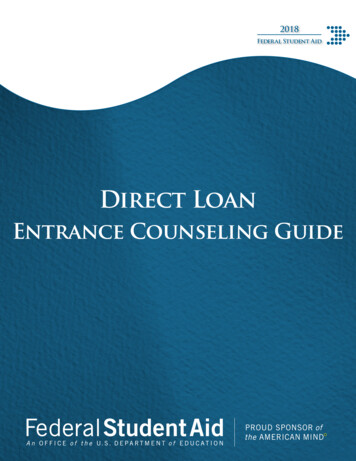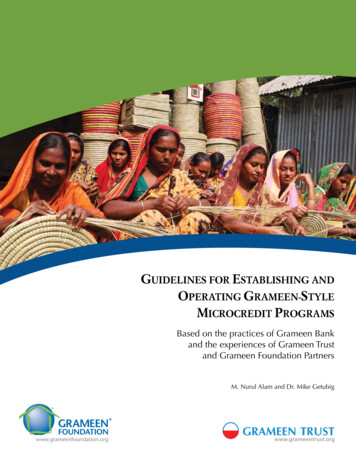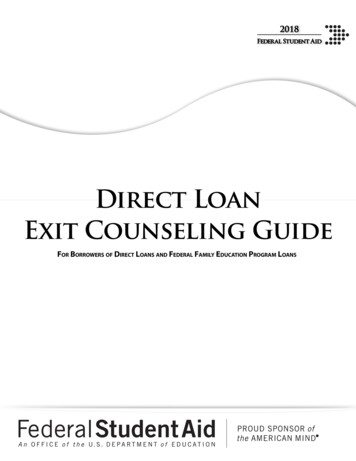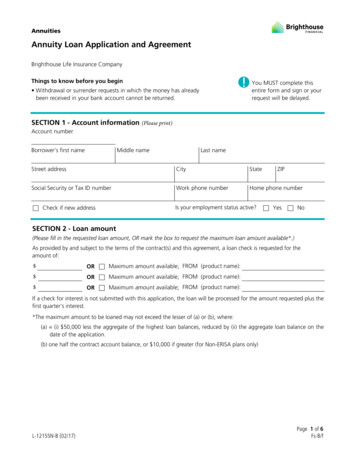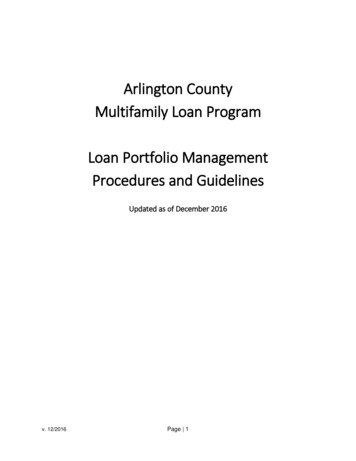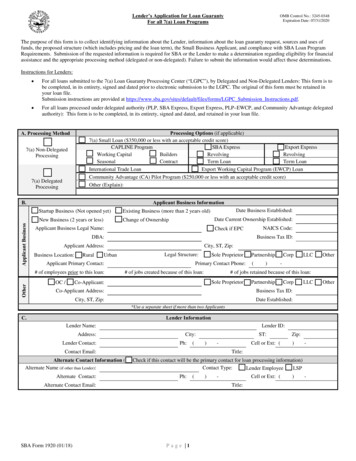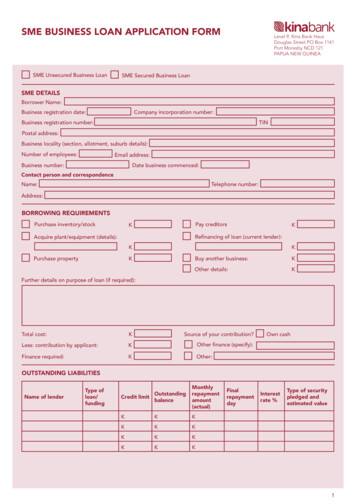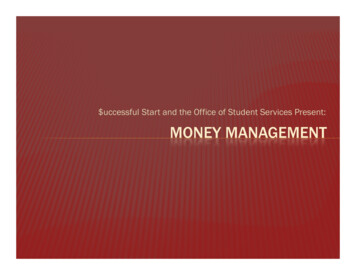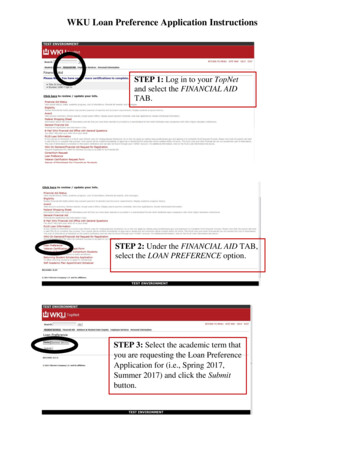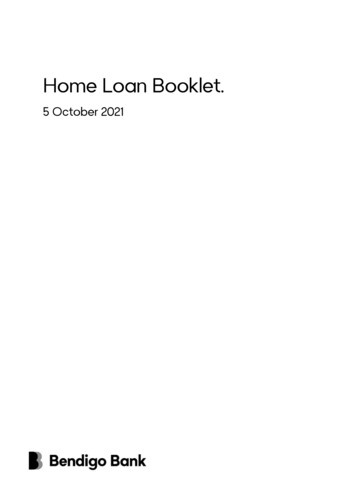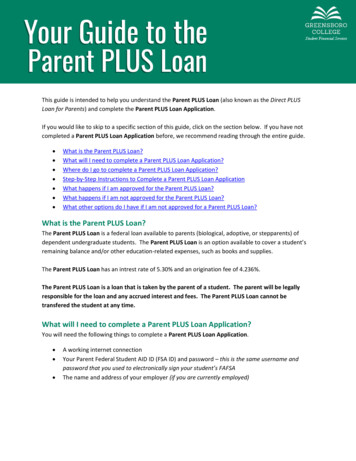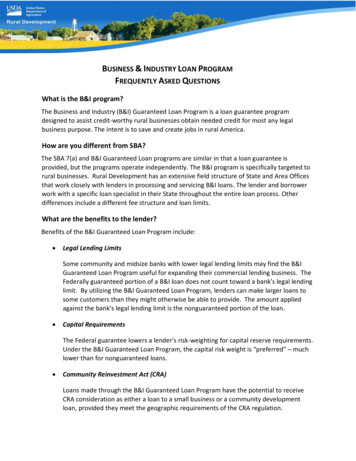
Transcription
BUSINESS & INDUSTRY LOAN PROGRAMFREQUENTLY ASKED QUESTIONSWhat is the B&I program?The Business and Industry (B&I) Guaranteed Loan Program is a loan guarantee programdesigned to assist credit-worthy rural businesses obtain needed credit for most any legalbusiness purpose. The intent is to save and create jobs in rural America.How are you different from SBA?The SBA 7(a) and B&I Guaranteed Loan programs are similar in that a loan guarantee isprovided, but the programs operate independently. The B&I program is specifically targeted torural businesses. Rural Development has an extensive field structure of State and Area Officesthat work closely with lenders in processing and servicing B&I loans. The lender and borrowerwork with a specific loan specialist in their State throughout the entire loan process. Otherdifferences include a different fee structure and loan limits.What are the benefits to the lender?Benefits of the B&I Guaranteed Loan Program include: Legal Lending LimitsSome community and midsize banks with lower legal lending limits may find the B&IGuaranteed Loan Program useful for expanding their commercial lending business. TheFederally guaranteed portion of a B&I loan does not count toward a bank’s legal lendinglimit. By utilizing the B&I Guaranteed Loan Program, lenders can make larger loans tosome customers than they might otherwise be able to provide. The amount appliedagainst the bank’s legal lending limit is the nonguaranteed portion of the loan. Capital RequirementsThe Federal guarantee lowers a lender’s risk-weighting for capital reserve requirements.Under the B&I Guaranteed Loan Program, the capital risk weight is “preferred” – muchlower than for nonguaranteed loans. Community Reinvestment Act (CRA)Loans made through the B&I Guaranteed Loan Program have the potential to receiveCRA consideration as either a loan to a small business or a community developmentloan, provided they meet the geographic requirements of the CRA regulation.
ProfitabilityThere are several ways that the B&I program can help increase bank profitability. Byminimizing credit risk and expanding the universe of business loans that they canoriginate, this product allows banks to earn fees and interest on loans they might nothave otherwise made. Additionally, the guaranteed, and, to a lesser extent, thenonguaranteed, portions of a B&I loan can be sold into the secondary market orparticipated. This process can generate fees and loans can be sold for a premium,depending on rate, maturity, and market conditions. Liquidity ManagementLiquidity management policies for lenders typically direct them to have sufficient assetson their books that can be easily converted to cash if needed. There is a secondarymarket for the guaranteed portion of B&I loans. By selling these loan portions, lenderscan help manage liquidity issues, which can enable them to recycle funds for new loansor use the proceeds for other purposes. Mitigating RiskThe B&I Guaranteed Loan Program generally provides a 60 percent to 80 percentFederal guarantee on business loans depending on the size of the loan. This is aguarantee against loss. If there is a loss on the loan after liquidating the collateral,USDA will reimburse the lender for a portion of the loss, on a pro-rata basis, based onthe percentage of guarantee. New Business Development OpportunitiesLenders can offer eligible applicants B&I guaranteed loans that generally have betterrates and longer terms than a conventional loan. Businesses receiving B&I loans maybecome repeat customers. Furthermore, B&I borrowers may open additional accountswith their lending institution, establishing full banking relationships, such as checkingand payroll accounts.What are the benefits to the borrower?Borrowers can benefit from better pricing and terms with the B&I loan guarantee in place thanare typically given with conventional loans. The loans must be fully amortized, without calls orballoon repayment structures. Longer terms can reduce additional loan fees that may beincurred in the future on shorter term loans or balloon loans. The interest rates for the loansare negotiated between the lender and the applicant and may be either fixed or variable (or acombination of fixed and variable).USDA is an equal opportunity provider, employer and lender.2
Am I an eligible lender?Regulated lenders subject to credit examination and supervision by a Federal or State agencyare eligible to participate in the B&I program, including Federal and State-chartered banks,Farm Credit System banks, savings banks, and savings and loan associations. Non-regulatedlenders, such as insurance companies, community development corporations and mortgagecompanies with successful commercial lending experience, may apply for eligibility to theUSDA.How is Tangible Balance Sheet Equity determined?In order to ensure that the business itself is solvent, the Agency requires that the borrowerdemonstrate minimum levels of tangible balance sheet equity. Specifically, a minimum of ten(10) percent is required for existing businesses. Twenty (20) percent is required for newbusinesses. A minimum range between twenty-five (25) and forty (40) percent will be requiredfor energy projects.Only business assets are included in the analysis. Appraisal surplus, bargain purchase gains,and intangible assets are not considered. Owner subordinated debt may be included when thesubordinated debt is exchanged for cash injected into the business and remains in the businessfor the life of the guaranteed loan. The B&I guaranteed loan may be for an amount to finance100 percent of the borrower’s capital needs if the business can meet collateral and equityrequirements.What types of businesses are eligible?Businesses with facilities located in rural areas that save or create jobs. Most types ofbusinesses are eligible, including those engaged in the manufacturing, wholesale, retail andservice industries. Eligible entities include partnerships, individuals, cooperatives, for-profitand nonprofit corporations, including publicly-traded companies, tribal groups, or publicbodies. Any size business may be eligible, but there are certain industries that may berestricted.How do I know if an area is “rural”?Normally, projects seeking a B&I guaranteed loan need to be located in eligible rural areas,which include all areas other than cities or towns larger than 50,000 people and the contiguousand adjacent urbanized area of such cities or towns. Cooperative organizations and local foodsprojects may be funded in both rural and urban areas in certain circumstances. Eligibility of asite may be determined by entering the address at the following ility/welcomeAction.doUSDA is an equal opportunity provider, employer and lender.3
What are eligible uses of loan funds?Loan proceeds may be used for essentially any business purposes, including but not limited tothe following: Business acquisitions, construction, conversion, expansion, repair, modernization anddevelopmentPurchase of equipment, machinery, and suppliesStartup costs and working capitalProjects supported by New Markets Tax CreditsDebt refinancing under certain conditionsCan funds be used to refinance a loan?The debt refinancing must improve cash flow while creating or saving jobs. If a lender wishes torefinance a loan already in its portfolio, the loan being refinanced must be closed and currentfor at least the past 12 months and may not exceed 50 percent of the overall loan unless theloan is Federally guaranteed.What are the fees?There is a one-time guarantee fee, currently set at three (3) percent of the guaranteed principalamount, due when the guarantee is issued.There is also an annual renewal fee required to maintain the guarantee. The rate of the annualrenewal fee (a specified percentage) is established by Rural Development in an annual noticepublished in the Federal Register and is currently set at 0.50 percent. The rate is the rate ineffect at the time the loan is approved and will remain in effect for the life of the loan. Allprogram fees are the responsibility of the lender but are typically passed on to the borrower.Other typical lender costs may also be assessed by the lender.Are prepayment penalties allowed?Yes, prepayment penalties are allowed.What are the maximum loan terms?Loan terms are negotiated between the lender and borrower but are subject to programmaximums that vary with the purpose of the loan. Terms may be blended, as appropriate: Working Capital - 7 years Machinery and Equipment - 15 years or useful life, whichever is less Real Estate - 30 yearsUSDA is an equal opportunity provider, employer and lender.4
What interest rate structures are allowed?Interest rates for loans may be fixed or variable or a combination of fixed and variable. The rateis negotiated between the lender and the borrower and will not be more than those ratescustomarily charged to other borrowers in similar circumstances. Variable rates cannot beadjusted more frequently than quarterly.Is the loan required to be fully secured?Collateral must have a documented value sufficient to protect the interest of the lender and theAgency. Lenders must discount collateral consistent with the sound loan-to-value policyoutlined in program regulations, and the discounted collateral value must be at least equal tothe loan amount.Are Personal Guarantees Required?Generally, unconditional personal and corporate guarantees are required from individuals andentities owning 20 percent or more of the borrowing entity.What are the maximum percentages of guarantee?The maximum percentage of guarantee is based on loan size. The scale of maximumpercentages is: 80 percent guarantee on loans up to and including 5 million70 percent guarantee on loans greater than 5 million up to and including 10 million60 percent guarantee on loans greater than 10 millionA limited amount of guarantee authority for guarantees of up to 90 percent is available forloans of 5 million and less that are high-priority projects.What is the typical size for a B&I loan?Typically, B&I loans range from 200,000 to 5 million, with an average size of about 3 million.There is no minimum loan amount, but loans cannot exceed 10 million without an exceptionby the Administrator.When is the Loan Note Guarantee issued?The guarantee is issued when the loan is closed and all conditions of the ConditionalCommitment, which outlines the terms of the guaranteed loan, have been met. A B&I loanguarantee may be issued prior to completion of construction under certain conditions.Is there an active B&I secondary market?Yes. There is an active secondary market for the guaranteed portion of B&I loans. Many buyersof guaranteed loans under the Small Business Administration (SBA) will also buy the guaranteedUSDA is an equal opportunity provider, employer and lender.5
portion of USDA loans. By selling these loan portions, banks can help manage liquidity issues,which can enable them to recycle funds for new loans or use the proceeds for other purposes.Essentially, the secondary market enables lenders to enhance liquidity and increase profitabilitywhile limiting financial exposure.Many lenders sell loans on the secondary market directly to investors, negotiating servicingspreads and selling at a premium.B&I loans are also eligible to be sold or exchanged for securities to Farmer Mac. Farmer Mac isa Federally chartered secondary market, much like Fannie Mae for single-family residentialmortgage loans but specifically geared to USDA (including B&I) guaranteed loans. Unlike theSBA secondary market where the lender’s return comes primarily from the one-time sale of theguarantee at a premium, with Farmer Mac the lender continues to earn the full spreadbetween the note rate and the Farmer Mac base rate.What are the servicing responsibilities required by the Agency?The lender is responsible for servicing the entire B&I loan (both guaranteed and nonguaranteedportions) in a prudent manner for the life of the loan. Generally, the B&I loan servicingrequirements are fairly standard, but lenders should be sure to review the regulations and todiscuss requirements with the relevant USDA Rural Development field office staff. The lenderneeds to keep the Agency informed of the servicing actions being taken on the loan and obtainprior Agency concurrence for some non-routine serving actions, such as subordinations, loanrestructuring, bankruptcies, collateral releases, etc.What are the reporting requirements?In addition to servicing the loan, lenders must meet all the reporting and other communicationsrequired by the B&I Guaranteed Loan Program. These include the following: The lender must report the outstanding principal and interest balance on eachguaranteed loan semiannually. The lender is required to report on defaulted loans eachmonth.At the USDA’s request, the lender will meet with USDA staff to ascertain how theguaranteed loan is being serviced and that the conditions and covenants of the LoanAgreement are being enforced. These lender meetings are typically held annually.The lender must obtain the borrower’s annual financial statements and submit them tothe USDA. The lender must also analyze the borrower’s financial statements andprovide a written summary to USDA. Lenders are also asked to provide an annualreport of the number of jobs employed by the borrower.USDA is an equal opportunity provider, employer and lender.6
Who do I submit my reports to after closing the loan?Lenders should work with their State Offices in determining who the contact person is forservicing the loan in that State. Submission of semi-annual and loan default reports andpayment for annual renewal fees can be made online through the Lender Interactive NetworkConnection (LINC). Your State Office contact will provide you information on how to obtain anID and password for LINC.What happens in the event of loan default?The lender must notify the Agency when a borrower is more than 30 days past due on apayment and the delinquency cannot be cured within 30 days or is otherwise in default of theLoan Agreement. Form RD 1980-44, "Guaranteed Loan Borrower Default Status," will be usedand the lender will continue to submit this form each month until such time as the loan is nolonger in default. If a monetary default exceeds 60 days, the lender must meet with the Agencyand, if practical, the borrower to discuss the situation.How does USDA honor the guarantee?The guarantee is supported by the full faith and credit of the United States and is incontestableexcept under the circumstances of fraud or misrepresentation of which the Lender has actualknowledge at the execution of the guarantee or of which the Lender participates in orcondones. However, any loss payment on the loan will be reduced by the amount that thelender’s actions or inactions resulted in loss.Do all State Offices operate the same?All State Offices operate under the same regulations and authorities and Rural Developmentstrives for uniform, consistent program delivery. However, processing and servicing approvalauthority does vary from State to State, as well as the State allocation of B&I funding each fiscalyear. Funding allocations are formula driven and are generally based on a State’s ruralpopulation. When a State allocation is exhausted, funds may be requested from a NationalOffice reserve account.Applications are submitted to Rural Development’s network of State and Area offices.Applications are received and processed in the appropriate Rural Development State or AreaOffice based on the location of the project to be financed. Most State Offices have authority toapprove guarantees for loans up to and between 5 and 10 million. Applications for loansexceeding the authority of the State Office are processed by the State Office but are submittedto the National Office for concurrence.What is the application process?The lender works with the borrower to submit an application to the Rural Development StateOffice where the business is located. The Agency will meet with all parties and make aUSDA is an equal opportunity provider, employer and lender.7
preliminary determination of project eligibility. The Agency will also work with the lenderbased on information submitted in the complete application. If the Agency finds the projecteligible and creditworthy, the Agency will issue a Conditional Commitment, approving the loanguarantee subject to conditions. After the lender closes the loan, the Agency will issue theLoan Note Guarantee after verifying that all conditions have been met.What type of environmental review is required?As a Federal program, all B&I assistance is subject the National Environmental Policy Act (NEPA)and other Federal guidelines designed to assure that Federally-supported projects do not harmthe environment. Consequently, USDA must complete an environmental analysis on all B&Iprojects. The level and complexity of environmental review will depend on the scope ofproject.How long does the application process take?Upon receipt of a complete application, lenders can expect an Agency response within 30-60days. Response times can vary based on complexity and scope of the project. For example, aconstruction project can take longer due to environmental clearances, whereas a refinancingproject may be completed in a shorter timeframe.Where do I find the loan application form?Most forms are located on the USDA Rural Development website:https://www.rd.usda.gov/Required forms for Rural Development Guaranteed Loan Applications include: Form RD 4279-1 - (DOC, 316 KB) Application for Loan Guarantee (B&I and REAPProgram)Form RD 4279-2 - Certification of Non-Relocation & Market & Capacity InformationReport - only for loans 1MM creating 50 jobsWhere can I find the governing regulations?Program regulations can be found at the following Web ons-guidelines/Program regulations for the B&I Guaranteed Loan Program are: General – RD Instruction 4279-ALoanmaking – RD Instruction 4279-BLoan Servicing – RD Instruction 4287-BUSDA is an equal opportunity provider, employer and lender.8
If I have further questions, who do I contact?You should contact your State Office for additional information in the State in which the projectis located. A list of offices and additional information can be obtained USDA is an equal opportunity provider, employer and lender.9
Guaranteed Loan Program useful for expanding their commercial lending business. The Federally guaranteed portion of a B&I loan does not count toward a bank's legal lending limit. By utilizing the B&I Guaranteed Loan Program, lenders can make larger loans to some customers than they might otherwise be able to provide. The amount applied
